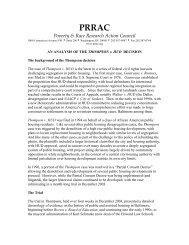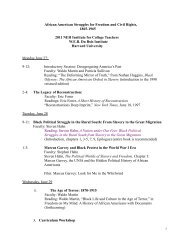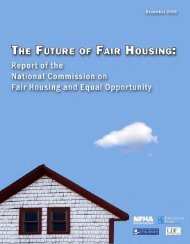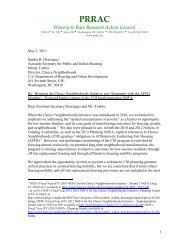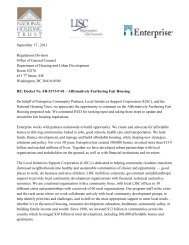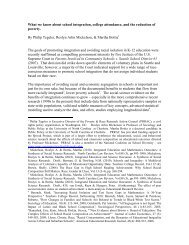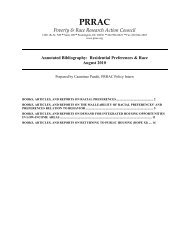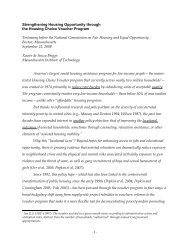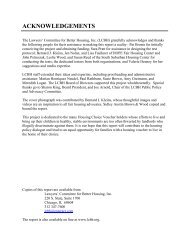The Spatial Concentration of Subsidized Housing - Poverty & Race ...
The Spatial Concentration of Subsidized Housing - Poverty & Race ...
The Spatial Concentration of Subsidized Housing - Poverty & Race ...
You also want an ePaper? Increase the reach of your titles
YUMPU automatically turns print PDFs into web optimized ePapers that Google loves.
Galster andZobel 1998Freeman andBotein 2002Nguyen 2005Studiesfrom1987-1997Studiesfrom1974-2001Studiesfrom1963-2001Each studyis differentEach studyis differentEach studycovers onecity orcountyEach study isdifferent,primarily sitebasedEach study isdifferent,primarily sitebasedEach study isdifferent,primarily sitebasedLITERATURE REVIEWSDispersion,property values,behavior changeProperty values,racial transition,povertyconcentration andcrimeProperty valuessurrounding thesubsidizedhousing<strong>The</strong>oretical and meta-analysis <strong>of</strong>existing studies. Three types <strong>of</strong>studies are included: 1) casestudies <strong>of</strong> participants indispersion programs; 2)statistical studies on the impacton property values; and 3)statistical studies onneighborhoods and behavior.Literature review <strong>of</strong>neighborhood effects <strong>of</strong>subsidized housing includingimpacts on 1) property values; 2)racial transition; 3) povertyconcentration and 4) crime.Discussion <strong>of</strong> methodologicalproblems in designing researchto answer these questions.Literature review on impacts toproperty values in areassurrounding subsidized housing.Early studies use matchedneighborhoods and later onesuse hedonic price regression tocontrol for factors other than thelocation <strong>of</strong> the subsidizedhousing.<strong>The</strong>re will be benefits to the overall systemif people move out <strong>of</strong> high poverty areasinto the lowest poverty areas but there islittle empirical evidence in support <strong>of</strong>housing dispersal on neighborhood povertyor social behaviors.Studies using hedonic price models weremixed with slight negative, no impact orlarge positive impacts on property values.Studies <strong>of</strong> impacts <strong>of</strong> vouchers were mixedas to positive and negative impacts. Twostudies on the impact on racial change foundno impact or a small impact notcharacterized as "white flight". <strong>The</strong>re areserious methodological problems withalmost all the studies so that findings are notreliable. Future studies should use propermethodologies and more studies are neededon vouchers.Four findings: 1) negative effects (if theywere found) were small; 2) design andmanagement are important factors; 3)negative impacts are more likely if clusteredin high poverty neighborhoods; and 4) therewere a limited number <strong>of</strong> methodologicallysound studies. Qualitative studies areneeded to understand property ownermotivation. <strong>Housing</strong> market factors shouldbe considered in quantitative studies.202




